Hunterston: Old king coal to cable vision
- Published
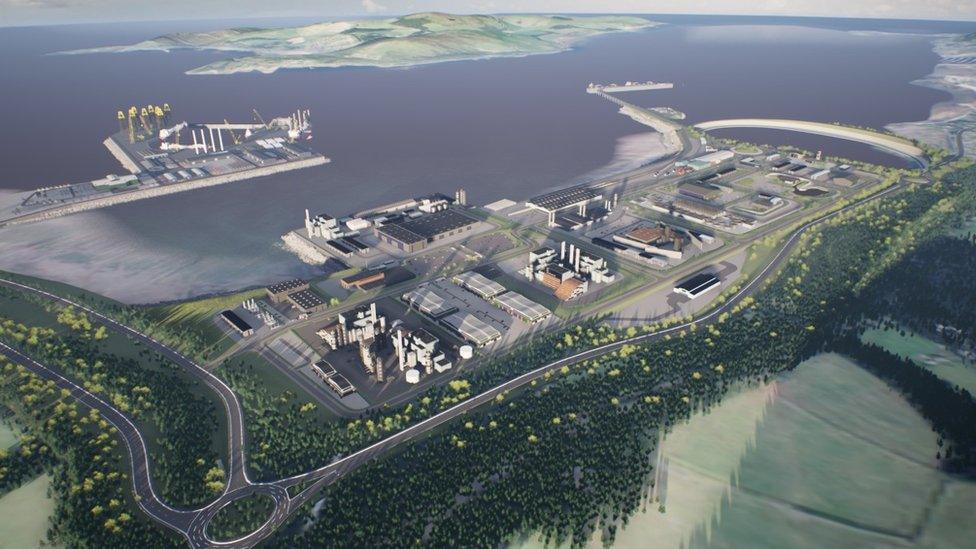
An artists impression of what Hunterston Port could look like in the future
A coastal wasteland of national economic significance is preparing for revival, and on a big scale.
Hunterston port's first project proposal could bring 900 manufacturing jobs and 400 in construction, targeting a market for high-voltage subsea cables.
Further plans range across offshore wind, a data centre, nature conservation and research into onshore fish and seaweed farming.
There's been a recent reminder that big visions for green energy have led to disappointing outcomes, but this time the sector believes the wind has changed for the better.
"It's ranked as the number one most significant site for development in Scotland," claims Jim McSporran.
Mr McSporran, ports director at Clydeport, says this is down its long list of assets: "320 acres of usable brownfield land, the biggest dry dock in Europe, the biggest jetty in Europe, deepest water - great facilities."
Clydeport is nearly finished with the £10m programme for clearing North Ayrshire's former iron ore and coal yard.
Supplying Ravenscraig steelworks with iron ore from the 1970s and then Longannet and Cockenzie power stations with imported coal, that bulk business came to an end in 2016.
Nothing is left except three conveyor belt ramps, which are soon to go, and the head office, including its landmark harbour-master's control tower.
Where there used to be mounds of coal, going through the port at a rate of up to 10 million tonnes per year, there are now just flocks of geese, leaving their footprints in the coal dust.
On behalf of Clydeport's owner, Peel Ports, Jim McSporran is now marketing what Hunterston can become next.
He says 35 companies are already engaged in auctions for sites or taking options.
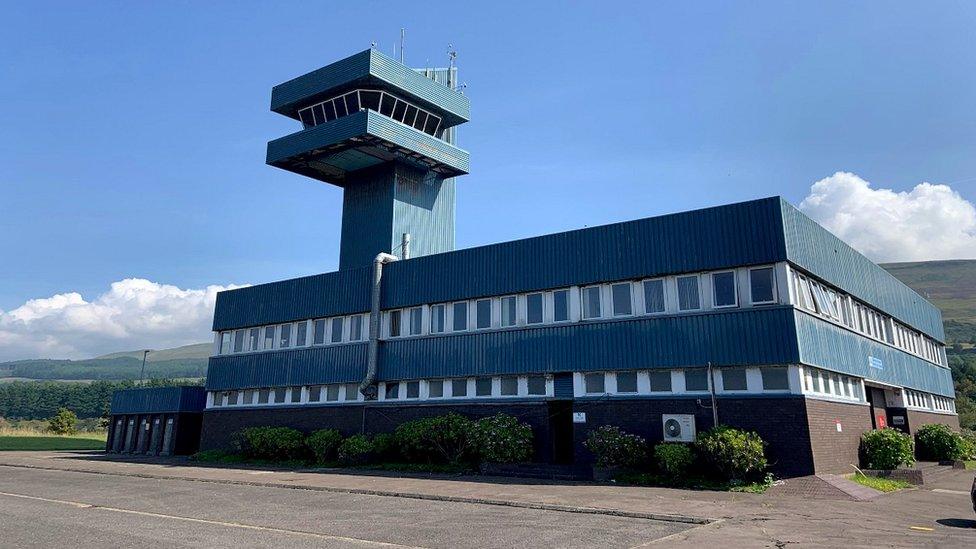
The landmark harbour-master's control tower is the last building left
Graphic artists have been hard at work on showing how it might look - "more like a university campus than an industrial site", he says, pointing out its green corridors and work with nature conservationists.
Metal core
The first big prospect has been put to the local community this week.
A new company, XLCC, has lodged plans to build a factory for making sub-sea high-voltage cables. It would cover 70 acres of the site, the area of 11 football pitches.
And it would employ up to 900 people, not including the 400 required for its construction over the next four years.
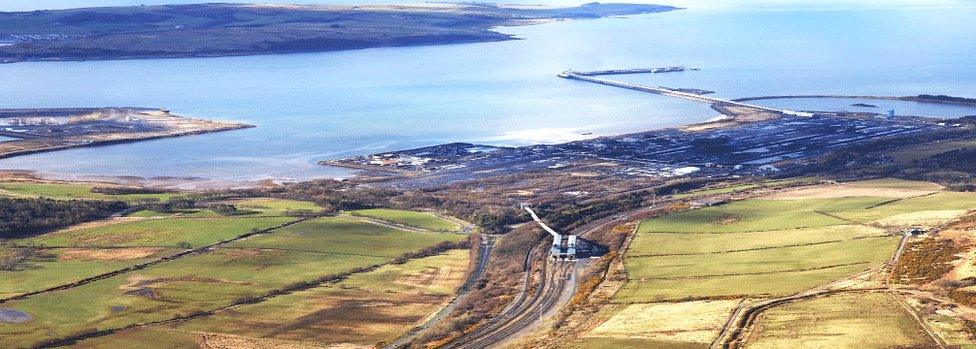
The site has been cleared of all its coal-related infrastructure
From Alan Mathers, a director at the ambitious start-up, the numbers roll on: 2,400 kilometres of cable each year "the width of a man's leg".
It is foreseen as requiring 30,000 tonnes of aluminium, 90,000 tonnes of lead, 90,000 tonnes of steel wire (with a pledge to buy that from British steel-makers, protecting at least 600 jobs), and 8,000 tonnes of bitumen.
Each metre of cable weighs 70 kilograms. With two running in parallel, their weight puts them at risk of internal damage if they bend too much.
They are to be carefully wound from the factory, along the quayside and on to carousels on XLCC's ship, and gingerly laid on the seabed in 150km- sections. Each load weighs more than 20,000 tonnes.
High-voltage sub-sea cable is necessary in large lengths, to get offshore wind power on to the shore, and to connect up countries as far away as North Africa.
The manufacturing capacity in Europe is currently below 3,000 kilometres per year, and XLCC wants its Scottish plant, plus one in South Wales, to produce 4,000km. Alan Mathers says his market research points to a nine-fold increase in demand over this decade.
The two plants require roughly £1bn investment, being sought from private equity, including around £200m for the ship, at 200 metres in length and more than 40 metres wide.
Its battery power is part of the response to Hunterston's neighbours that this could get noisy. XLCC is also trying to reassure them about the prospect of more heavy goods road traffic.
British bootstraps
There is already an Italian-made HVDC (High Voltage Direct current) cable linking Hunterston with Merseyside.
The ScottishPower investment takes surplus wind energy south, and when the wind drops, it brings nuclear, gas and imported power north into Scotland.
However, that project has not started well. Flaws in the Italian-made cable have meant its operations have been well below the current anticipated, and there was a fire at the Hunterston landfall plant for the conversion between direct and alternating current.
Getting guaranteed quality of manufacturing to the cables' aluminium core is vital, and a large part of the investment in equipment and staffing at the proposed XLCC factory. Once a cable is trenched two metres below the seabed, it is difficult and expensive to mend it.
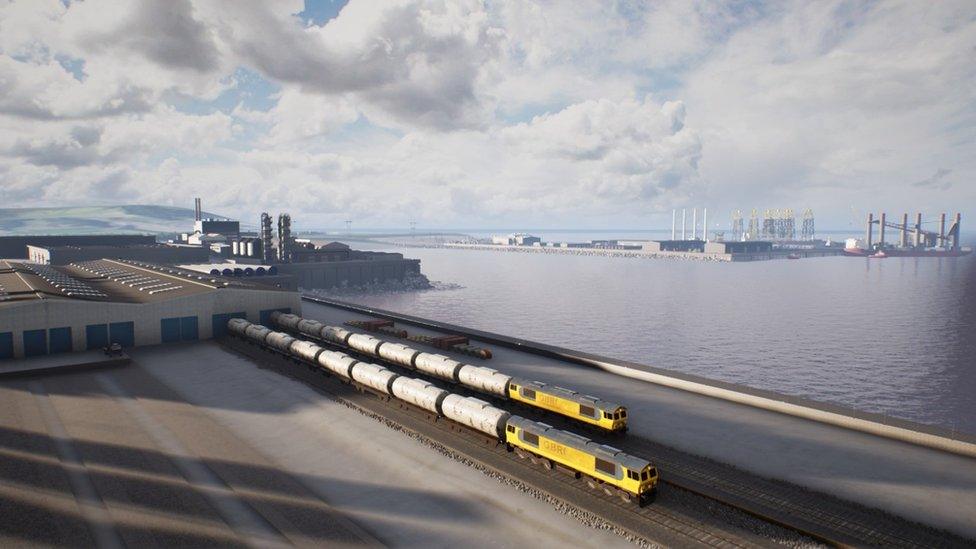
That 'bootstrap' cable, and another proposed from Peterhead into the east coast of England, will be all the more important when Hunterston's remaining nuclear power plant shuts down production.
Just to the south of the port, its operator, EDF, confirmed this week that "defuelling" is certain by 7 January next year. At that point many decades of decommissioning get started, with waste being removed by train from the port's railhead.
Vision to reality
Plans for other parts of the Hunterston site include an area for green energy, with a large laydown quayside area for offshore wind turbines and platforms. A vision of a circular energy use moves through bio-waste processing, feeding a power-hungry data centre.
These produce a lot of excess heat, which can be used for onshore fish farming and research into seaweed cultivation, with fish waste fed back into the energy plant.
Stirling University's aquaculture department is one of three universities already involved with the plans.
Will all this happen?
It takes some imagination, and the help of those graphic artists, to see what Hunterston Port and Resource Centre (PARC) could become.
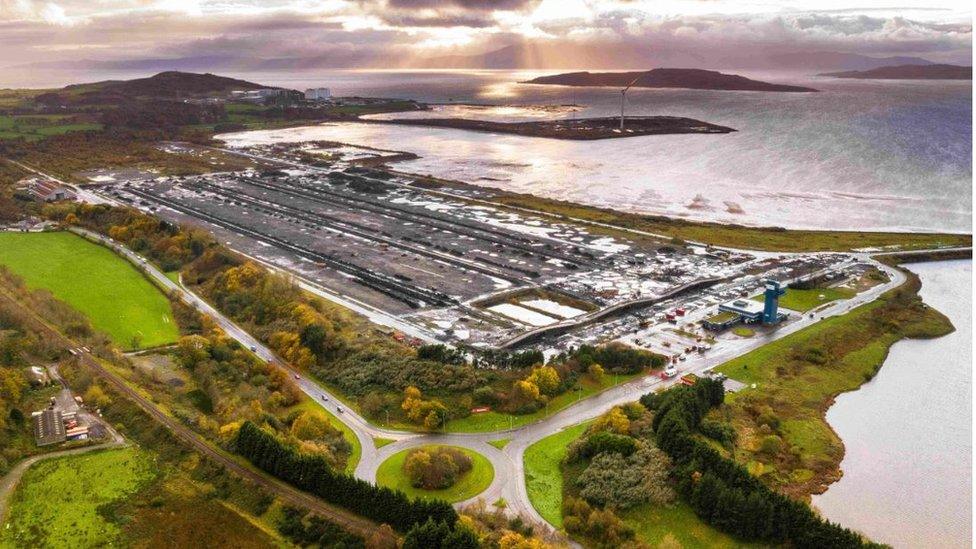
The Hunterston site covers 300 acres
It will take a lot of risk capital to make the XLCC cable-making vision become reality. As a new company, it lacks a track record. With his background in both corporate finance and manufacturing pipelines from Nigeria to Norway, Alan Mathers' response to that is that the technology is not new or experimental, and the market is well-researched and growing fast.
Port hub
Only last week, a report from the Scottish Offshore Wind Energy Council brought a reminder that bold ambitions have a habit of becoming quite small achievements - a vision of 28,000 jobs in "the Saudi Arabia of renewable energy" ended last decade on less than 1,000, and less than a tenth of the vision's capacity actually installed.
The renewables energy sector is confident that this time looks and feels different. According to Claire Mack, chief executive of Scottish Renewables, the next decade should see a 10-fold increase in offshore wind capacity around Scotland. The market for supplying that sector is burgeoning around the world.
Scotland has four or five ports with the scale to make the vision a reality, she says, and their involvement in this is necessary to unlocking the supply chain potential. What's needed is to get the projects under way, giving investors the confidence to build capacity to supply them.
That industry report points out that the way in which these projects are supported by a guarantee of a floor price for their energy has the effect of putting incumbent suppliers (mostly foreign) at an advantage, and requires fast response and big risk-taking in investments by new entrants to the market.
It chose the Cromarty Firth, including Nigg and Invergordon, as the best hub to capture supply and perhaps manufacturing opportunities in the next decade.
Jim McSporran is confident that Hunterston has what it takes to do that and more for Scotland's west coast, into the Irish Sea and beyond.

Related topics
- Published18 August 2021


